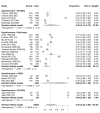Prevalence and Clinical Characteristics of Sleeping Paralysis: A Systematic Review and Meta-Analysis
- PMID: 38425633
- PMCID: PMC10902800
- DOI: 10.7759/cureus.53212
Prevalence and Clinical Characteristics of Sleeping Paralysis: A Systematic Review and Meta-Analysis
Abstract
Sleep paralysis (SP) is a mixed state of consciousness and sleep, combining features of rapid eye movement (REM) sleep with those of wakefulness. The exact cause of SP is unknown, and its prevalence varies among the studies. We aim to identify SP's global prevalence, the affected population's characteristics, and the SP's clinical picture. We searched three databases (PubMed, Scopus, and Web of Science (WoS)) using a unique search strategy to identify eligible studies. All observational studies identifying the prevalence or frequency of sleeping paralysis were included. No exclusions are made based on country, race, or questionnaire. The analysis was performed using the latest version of R software (R Core Team, Vienna, Austria). The analysis included 76 studies from 25 countries with 167,133 participants. The global prevalence of SP was 30% (95% CI (22%, 39%)). There were similar frequencies of isolated SP and SP (33%, 95% CI (26%, 42%), I2 = 97%, P <0.01; 31%, 95% CI (21%, 43%), I2 = 100%, P = 0, respectively). A subgroup analysis showed that the majority of those who experienced SP were psychiatric patients (35%, 95% CI (20%, 55%), I2 = 96%, P <0.01). The prevalence among non-psychiatric patients was among students (34%, 95% CI (23%, 47%), I2 = 100%, P = 0). Auditory and visual hallucinations were reported in 24.25% of patients. Around 4% had only visual hallucinations. Meta-regression showed no association between the frequency of SP and sex. Publication bias was detected among the included studies through visual inspection of funnel plot asymmetry. Our findings revealed that 30% of the population suffered from SP, especially psychiatric patients and students. The majority of SP cases lacked associated hallucinations, while a noteworthy proportion experienced combined visual and auditory hallucinations.
Keywords: hallucinations; isolated sleep paralysis; isp; prevalence; ptsd; sleeping paralysis; sp.
Copyright © 2024, Hefnawy et al.
Conflict of interest statement
The authors have declared that no competing interests exist.
Figures










Similar articles
-
Prevalence and Clinical Picture of Sleep Paralysis in a Polish Student Sample.Int J Environ Res Public Health. 2020 May 18;17(10):3529. doi: 10.3390/ijerph17103529. Int J Environ Res Public Health. 2020. PMID: 32443518 Free PMC article.
-
Prevalence Rates of the Incubus Phenomenon: A Systematic Review and Meta-Analysis.Front Psychiatry. 2017 Nov 24;8:253. doi: 10.3389/fpsyt.2017.00253. eCollection 2017. Front Psychiatry. 2017. PMID: 29225584 Free PMC article.
-
Experiences and beliefs related to sleep paralysis among the general population of the twin cities: A cross-sectional study.Sleep Med. 2024 Dec;124:146-153. doi: 10.1016/j.sleep.2024.09.022. Epub 2024 Sep 17. Sleep Med. 2024. PMID: 39303361
-
The Anatomy of the Stylohyoid Chain: A Systematic Review with Meta-Analysis.Diagnostics (Basel). 2025 Apr 3;15(7):925. doi: 10.3390/diagnostics15070925. Diagnostics (Basel). 2025. PMID: 40218275 Free PMC article. Review.
-
Recent Insights Into Sleep Paralysis: Mechanisms and Management.Cureus. 2024 Jul 26;16(7):e65413. doi: 10.7759/cureus.65413. eCollection 2024 Jul. Cureus. 2024. PMID: 39184697 Free PMC article. Review.
Cited by
-
Nightmares or a crippling reality? A review on sleep paralysis.J Family Med Prim Care. 2025 Jul;14(7):2639-2642. doi: 10.4103/jfmpc.jfmpc_212_25. Epub 2025 Jul 21. J Family Med Prim Care. 2025. PMID: 40814483 Free PMC article. Review.
-
Advances in brain and religion studies: a review and synthesis of recent representative studies.Front Hum Neurosci. 2024 Nov 29;18:1495565. doi: 10.3389/fnhum.2024.1495565. eCollection 2024. Front Hum Neurosci. 2024. PMID: 39677407 Free PMC article.
References
-
- Farooq M, Anjum F. StatPearls [Internet] Treasure Island (FL): StatPearls Publishing; 2024. Sleep paralysis. - PubMed
-
- Hypnagogic and hypnopompic hallucinations during sleep paralysis: neurological and cultural construction of the night-mare. Cheyne JA, Rueffer SD, Newby-Clark IR. Conscious Cogn. 1999;8:319–337. - PubMed
Publication types
LinkOut - more resources
Full Text Sources
